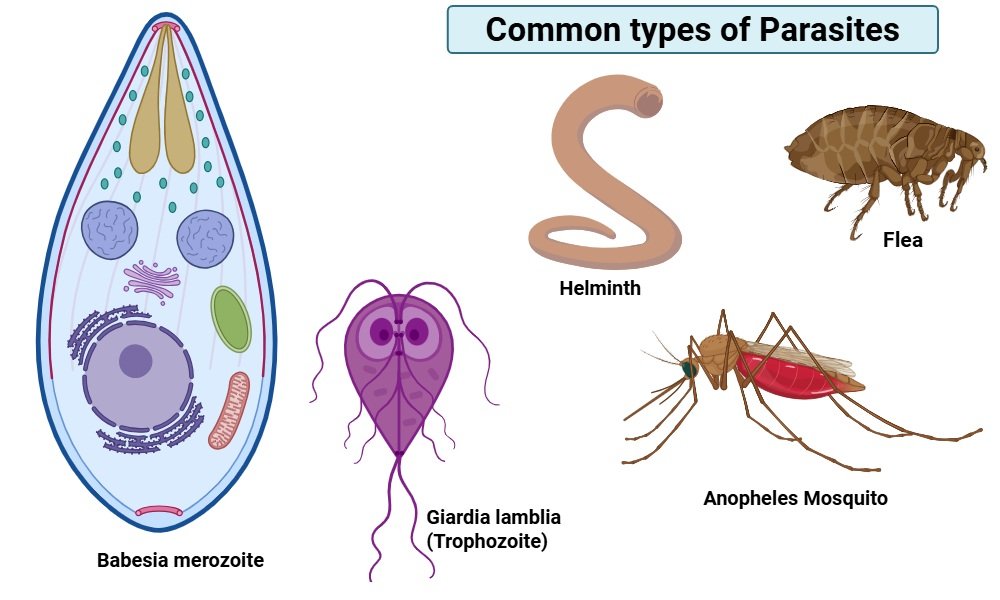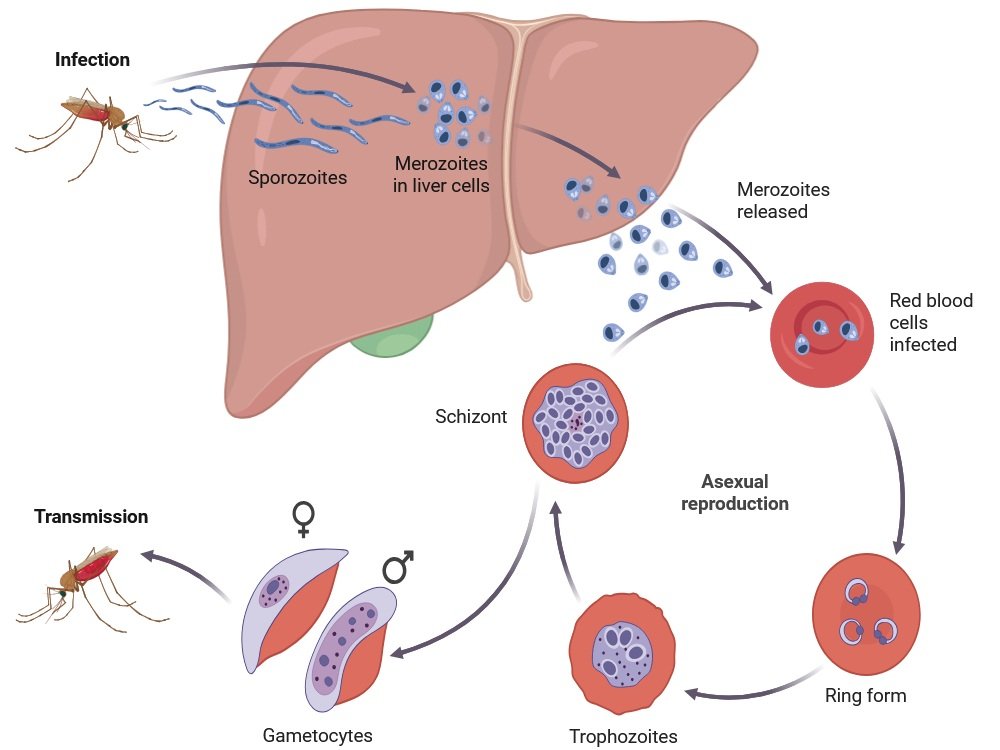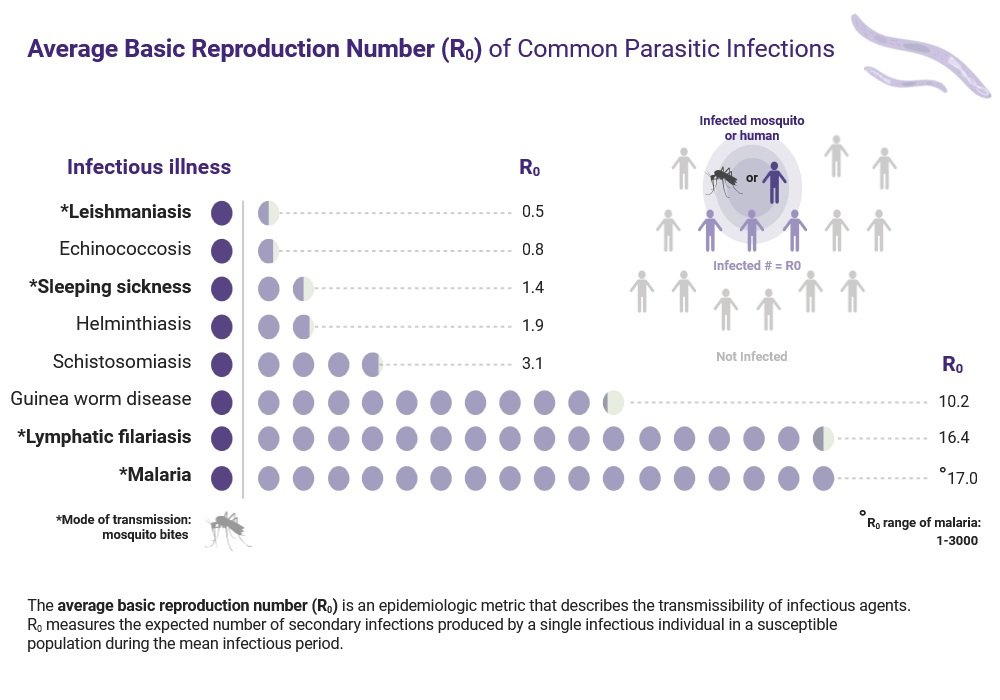Table of Contents
ToggleIntroduction to Parasitology
Parasitology is the branch of science that studies parasites, their biology, and the diseases they cause in humans and animals. Traditionally, it included the study of protozoa, parasitic worms (helminths), and arthropods that act as disease vectors.
A parasite is an organism that lives in or on another organism (host), feeding at the host’s expense. While some microbes exist as harmless commensals (e.g., Entamoeba coli), parasitic forms often cause disease.
Originally considered a zoological discipline, parasitology is now interdisciplinary, merging concepts from microbiology, immunology, biochemistry, ecology, and medicine.

Global Impact of Parasitic Diseases
Parasitic diseases are a major public health problem worldwide. They affect billions of people, especially in tropical and subtropical regions with poor sanitation and limited healthcare access.
- About 30% of the global population is infected with Ascaris lumbricoides.
- Malaria and schistosomiasis remain among the most prevalent parasitic infections.
- Immunocompromised patients (e.g., HIV/AIDS cases) are more vulnerable to parasites such as Cryptosporidium, Pneumocystis jirovecii, and Strongyloides.
- Migration and refugee crises increase the spread of parasitic diseases to new areas.
- Parasitic infections not only cause morbidity and mortality but also contribute to malnutrition, anemia, impaired growth, and socio economic burden in affected communities.
Classification of Parasites
Parasites are broadly classified into two kingdoms:
- Kingdom Protista: Protozoa (Single-Celled Parasites)
- Kingdom Animalia: Helminths (Multicellular Worms)
1. Kingdom Protista: Protozoa (Single-Celled Parasites)
- Microscopic, unicellular organisms.
- Commonly live in the blood, gut, or tissues of the host.
- Reproduce asexually (and sometimes sexually).
- Cause major diseases such as malaria, giardiasis, and amoebiasis.
a) Amebae
- Move and feed using pseudopodia (false feet).
Examples:
- Entamoeba histolytica → Amoebic dysentery.
- Naegleria fowleri → Primary amoebic meningoencephalitis (PAM).
b) Flagellates
- Move using flagella (whiplike appendages).
Examples:
- Giardia lamblia is the cause of giardiasis, a diarrheal illness.
- Trichomoniasis, a sexually transmitted illness, is caused by Trichomonas vaginalis.
c) Sporozoa (Apicomplexa)
- Don’t possess locomotor organs (Nonmotile).
- Possess intricate life cycles, including spore-like stages.
Examples:
- Malaria is caused by Plasmodium species and spread by Anopheles mosquitoes.
- Babesia → is the cause of babesiosis, a malaria-like illness spread by ticks.
- Toxoplasma gondii, which causes toxoplasmosis, is frequently spread by cat feces or undercooked meat.
d) Ciliates
- Move using cilia, which are minute hair like structures.
The only significant parasite of people:
- Balantidium coli → causes balantidiasis, a kind of intestinal illness.
2. Kingdom Animalia: Helminths (multicellular worms)
- Large, multicellular parasites visible in adult stages.
- Complex life cycles with intermediate hosts.
- Transmission often occurs through ingestion of eggs/larvae or skin penetration.
a) Nematodes (Roundworms)
- Worms those are cylindrical and not divided.
- Distinct genders (male and female).
Examples:
- Ascariasis is caused by the biggest intestinal roundworm, Ascaris lumbricoides.
- The hookworm, Ancylostoma duodenale, feeds on intestinal blood and causes anemia.
b) Tapeworms (Cestodes)
- Worms with flat segments.
- Having both male and female organs, i. e., being hermaphroditic.
- Use hooks or suckers to bind to the intestine.
Examples:
- Taenia species (beef and pig tapeworms) are the cause of taeniasis.
- Hydatid cyst disease is caused by Echinococcus granulosus in the liver, lungs, and other tissues.
c) Trematodes (Flukes)
- Leaf-shaped worms those are flat.
- Often uses a snail as an intermediate host.
Examples:
- The liver fluke Fasciola hepatica infects the liver and bile ducts, resulting in fascioliasis.
- Schistosoma species (blood flukes) are the cause of schistosomiasis (bilharzia), a significant tropical illness.
Life Cycle of Parasites
Direct: A parasite’s life cycle is referred to as direct if it only needs one host to finish its development. For instance, the whole life cycle of Entamoeba histolytica can only be completed in a human host.
Indirect: The parasite’s life cycle, which requires two or more host species to complete its development, is referred to as an indirect life cycle. For instance, the malarial parasite Plasmodium spp. needs both the mosquito and the human host to finish its life cycle.

Transmission of Parasites
The spread of parasitic diseases depends on the source of infection and mode of transmission.
1. Infection sources
Humans: The majority of parasitic infections originate from or are stored in humans. Anthoponosies are the conditions in which an infection spreads from one infected person to another.
Animals: Many parasitic illnesses have their roots in animals. Zoonosis is the name for the scenario in which diseases spread from animals to people.
2. Method of transmission
- Oral transmission: This occurs when the infectious stage of the parasite is ingested through contaminated food, water, vegetables, dirty fingers, or fomites contaminated with feces. The fecal-oral route is the name of this method of transmission. For example: Entamoeba histolytica cysts.
- Skin transmission: This is another significant method. When people walk barefoot on contaminated soil, the infectious larvae of hookworm penetrate their skin.
- Vector transmission: This can be accomplished by either biological or mechanical methods. Insect bites transmit several parasitic infections. For instance, Leishmania is vectored by the sand-fly.
- Transmission directly from one individual to another via physical contact. Sexual contact among homosexuals is a common means of transmission for Entamoeba, Giardia, and Trichomonas.
- Vertical transmission is the transmission from mother to child. Toxoplasmosis, for instance.
Host – Parasite interaction
Relationships between hosts and parasites are a component of ecological and evolutionary interactions. The nature of these interactions may be favorable (advantageous), neutral, or detrimental for one or both parties, depending on the circumstances.
Positive Interaction
1. Mutualism (+/+)
Definition: The interaction is sometimes necessary, meaning that the two organisms cannot live without one another, and in other cases, it is beneficial to both.
Examples:
- Pollination: Pollinators (bees, butterflies) obtain nectar or pollen as food, while plants have their pollen dispersed.
- Lichens are a symbiosis between a fungus and an algae or cyanobacterium. The fungus offers defense and support, while the alga produces food through photosynthesis.
- Mycorrhiza: The roots of plants are connected to fungi. Plants give sugars to fungi, but fungi aid in the uptake of water and minerals.
2. Protocooperation (+/+)
Definition: The connection between the two species is not required, but it does benefit both. They can live apart, but collaboration makes things simpler.
Example:
- The sea anemone and hermit crab: The anemone’s stinging cells protect the crab by attaching itself to its shell. The crab shifts the anemone to food sources.
- Cattle egret: Birds consume parasites from cattle, which provide pest control for the cattle.
3. Commensalism (0/+)
Definition: One organism (commensal) benefits, while the other (host) is unaffected.
Example:
- Epiphytes (plants that grow on trees): They don’t hurt the tree; they just use it as a platform to get sunlight.
- Whale barnacles: The whale is unaffected by the barnacles, but they benefit from the water currents because they provide a place to live and food.
- Crab within an oyster shell: The oyster is unharmed, and the crab is shielded.
Negative Interaction
1. Predation/Herbivory (+/–)
- One creature (predator/herbivore) gains from eating another (prey/plant), which is harmed.
- Predation: Prey is killed by a predator for food.
- Herbivory: Herbivores consume plants but typically do not kill them.
Example:
- The act of lions killing deer for food (predation).
- Grass-eating cows (herbivory).
- Plant leaves consumed by insects.
- Insect predation by carnivores such as Nepenthes.
2. Parasitism (+/-)
Definition: A parasite lives in or on its host, feeds, and causes damage, but often doesn’t kill right away because it depends on the host for survival.
Types: Ectoparasites live on the surface (ticks, lice, fleas).
Endoparasites: Live within the host’s body (malaria parasite, tapeworms).
Examples:
- The malaria parasite lives inside of red blood cells.
- The intestine is where the hookworm attaches and draws blood.
- The tapeworm is taking up nutrients in the intestine.
3. Amensalism (0/-)
Definition: Only one of the two organisms suffers damage.
Examples:
- Large grazing animals trampling little plants.
- The Juglone compound secreted by the black walnut tree prevents other plants in the area from growing, but the tree is immune.
4. Antibiosis (–/–)
Definition: Both species are negatively impacted, frequently by poisons or chemicals.
Examples:
- Although some fungi and actinomycetes release antibiotics that kill or prevent the growth of other microbes, the manufacture of these chemicals also costs the producer energy.
- Lichens produce compounds that inhibit the growth of bacteria and molds in the surrounding environment.
5. Competition (–/–)
The definition is that two species are competing for the same finite resources (food, space, partners, etc.) and that both have decreased growth, reproduction, or survival.
Types: Intraspecific competition: Between members of the same species. Interspecific competition: Occurs between different species.
Examples:
- The competition for seeds among finches in the Galápagos Islands.
- Two species of Paramecium those are cultivated together and competing for food. Plants competing for soil nutrients and sunlight.
Common Parasitic Infections
Some widespread human parasitic infections include:
- Malaria (Plasmodium spp.)
- Toxoplasmosis (Toxoplasma gondii)
- Head Lice (Pediculus humanus capitis)
- Giardiasis (Giardia lamblia)
- Pinworm Infection (Enterobius vermicularis)
- Trichomoniasis (Trichomonas vaginalis)
- Cryptosporidiosis (Cryptosporidium spp.)
- Cysticercosis (Taenia solium larvae)
- Strongyloidiasis (Strongyloides stercoralis)
- Leishmaniasis (Leishmania spp.)
- Schistosomiasis (Schistosoma spp.)

Symptoms of Parasitic Infections
Clinical manifestations vary with the type of parasite but may include:
- Fever and chills
- Fatigue and muscle pain
- Diarrhea, nausea, vomiting
- Abdominal cramps and anemia
- Skin rashes, itching, sores
- Neurological signs → confusion, seizures, severe headache
Diagnosis of Parasitic Infections
Parasitic infections can be diagnosed through:
- Traditional (Microscopic) Methods
- Biochemical Identification
- Molecular Methods
- Immunological Tests
1. Traditional (Microscopic) Methods
- Using samples like feces, blood, skin, or muscle tissue, it directly identifies parasites, larvae, or eggs.
- Examples: Blood smears (malaria), skin snips (filaria), and muscle biopsy (Trichinella).
2. Biochemical Identification
- Based on isoenzyme patterns, which are the distinct forms of the same enzyme found in parasites.
- Uses gel migration to differentiate between species and subspecies.
3. Molecular Identification
- Uses parasite DNA patterns for precise detection.
- Methods: PCR (amplifies tiny quantities of parasite DNA, such as malaria) and southern blotting (DNA probes).
4. Immunologic Diagnosis
- Using immune based tests, it identifies antigens or antibodies in blood.
- Examples: Antigen dipstick (mass screening/self-use), ELISA (Onchocerca), CATT test (sleeping sickness).
Conclusion
Parasitology is a vital discipline for understanding parasites, transmission, host interactions, and disease control. Parasitic infections continue to challenge global health systems, especially in tropical and developing regions.
Early diagnosis, prevention strategies, vector control, sanitation improvement, and public health education remain the most effective measures against parasitic diseases.
Frequently Asked Questions (FAQ) on Parasitology
Q1. What is parasitology?
Parasitology is the scientific study of parasites, their biology, life cycles, transmission, and the diseases they cause in humans and animals.
Q2. What are the main types of parasites?
Parasites are mainly classified into:
• Protozoa (e.g., Plasmodium, Giardia).
• Helminths (roundworms, tapeworms, flukes).
• Arthropods that act as vectors (mosquitoes, lice, ticks).
Q3. How are parasites transmitted?
Parasites spread through contaminated food/water (fecal-oral route), skin penetration, insect vectors (mosquitoes, sandflies), direct person-to-person contact, and mother-to-child (vertical transmission).
Q4. What are some common parasitic diseases?
Some widespread parasitic diseases include malaria, giardiasis, toxoplasmosis, amoebiasis, schistosomiasis, leishmaniasis, hookworm infection, and tapeworm infestations.
Q5. What are the symptoms of parasitic infections?
Symptoms vary but often include fever, fatigue, diarrhea, abdominal pain, nausea, vomiting, skin rashes, anemia, and in severe cases, neurological issues like seizures or confusion.
Q6. How are parasitic infections diagnosed?
Diagnosis is done using:
• Microscopy (blood smears, stool examination).
• Biochemical methods (enzyme patterns).
• Molecular methods (PCR, DNA probes).
• Immunological tests (ELISA, antigen dipsticks).
Q7. What is the difference between direct and indirect parasite life cycles?
• Direct life cycle: Parasite completes its development in a single host (e.g., Entamoeba histolytica).
• Indirect life cycle: Requires two or more hosts (e.g., Plasmodium needs humans and mosquitoes).
Q8. How can parasitic infections be prevented?
Prevention includes practicing good hygiene, using clean drinking water, proper cooking of food, wearing shoes, vector control (mosquito nets, repellents), deworming programs, and health education.
Q9. What is the difference between endoparasites and ectoparasites?
• Endoparasites live inside the host’s body (e.g., tapeworms, Plasmodium).
• Ectoparasites live on the surface of the host (e.g., lice, ticks, fleas).
Q10. Why is parasitology important in medicine?
Parasitology is crucial for identifying parasites, diagnosing infections, guiding treatment, controlling outbreaks, and improving public health worldwide.
Also Read
- Detection of Viruses: Modern Methods, Applications, and Advancements
- Culture Staining Techniques in Microbiology: Types, Methods, and Applications
- Antibiotics: Introduction, History, Mechanism and Applications
- Microbiology: From Microorganisms to Career Opportunities
- Microscopy: Principles, Types, and Applications
- Spirulina: The Superfood Microalga with Limitless Potential
- Bacteriology Quiz
- Basic Microbiology Quiz
- Virology Quiz
- Medical Microbiology Quiz
- Bacteriology Notes
- Immunology Notes

